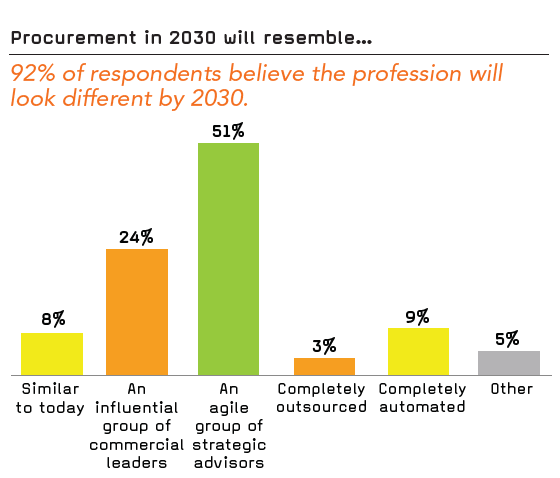
Nowadays, telecom companies, even the small and mid-sized, are putting efforts into the telecom procurement process.
According to KPMG, procurement is allowing to keep pace with business demands, improving business partnerships and shift the focus to strategic and sustainable value creation.
Due to its benefits, the procurement market has continuously grown these last years (Statista). With this growth, there are already previsions about what procurement will be in the future:

That said, we prepared :
- Why do companies need an optimized telecom procurement process?
- Current Telecom Procurement Process for B2B Companies
- 11 Tips to Improve your Telecom Procurement Process:
- Identify problems
- Have a standard process that works for everyone
- Use automated processes and tools
- Better negotiation techniques
- Educate your team
- Communicate with your team and suppliers
- Define a process to source for new opportunities
- Create a centralized directory of suppliers
- Define and evaluate team KPI’s
- Centralize Information
- Invest on a digital platform like a marketplace
Why do companies need an optimized telecom procurement process?
Procurement, in simple words, manages and evaluates the efficiency of different processes of a business. It’s involved in the process of optimizing supply chain operations, managing supplier relationships, negotiating prices, and improving material costs. Procurement can directly impact on how much a business can save while meeting its goals.
The process of procurement isn’t the same for all businesses, as every industry has its own requirements. Industries’ specifications in identification, negotiation, purchasing and in payment processes changes the procurement process.
One common influence that has been changing procurement processes in all industries is the accelerated digital transformation. It has emphasized the existent challenges in procurement and its helping to solve them.
For telcos in B2B, adapting and optimizing the telecom procurement process is important so they’re able to obtain all the benefits procurement can bring.
Current Telecom Procurement Process for B2B Companies
The most common telecom procurement process used by telcos worldwide is Request for Proposal or Quotation (RFP or RFQ).
In these processes, the company outlines its requirements and invites suppliers to submit proposals, detailing how they would fulfill the requirements and providing cost estimates.
The company then evaluates the proposals and selects a supplier based on criteria such as price, quality, and experience.
The typical steps in the Request for Proposal or Quotation procurement processes are:
- Requirements definition: The company clearly defines its needs and requirements for the goods or services it wishes to procure.
- Invitation to bid: The company invites potential suppliers to submit proposals by distributing the RFP document.
- Proposal submission: Suppliers review the RFP and submit their proposals, which typically include a description of their goods or services, price estimates, and other relevant information.
- Proposal evaluation: The company evaluates the proposals received and ranks them based on various factors such as cost, quality, and experience.
- Contract negotiation: The company selects one or more suppliers and begins negotiations to finalize the contract.
- Contract award: Once the negotiations are complete, the company awards the contract to the successful supplier.
- Contract implementation: The supplier begins delivering the goods or services specified in the contract, and the company pays for them according to the terms agreed upon.
- Monitoring and review: The company regularly monitors the supplier’s performance and reviews the contract to ensure that the supplier is fulfilling its obligations according to SLA’s (Service Level Agreements) defined on the contract.
Even though this telco procurement process works, improvements can be made to further optimize the results.
11 Tips to Improve your Telecom Procurement Process
To take full advantage of procurement, there are some tips you can follow to improve the telecom procurement process:
1. Identify problems
In the beginning, it’s important to conduct a thorough needs assessment, to identify the necessities and requirements of the company. Doing this, you can better guarantee that the right decisions are being made when producing products and services.
2. Have a standard process that works for everyone
Create precise specifications. The needs of the company will be met if the specifications are well stated. Standardized procedures make it simpler to monitor results by establishing norms and criteria. These can greatly reduce human error in the procurement process.
3. Use automated processes and tools
By automating many of the operations involved in procurement, such as writing purchase orders, monitoring delivery and payments, and managing supplier relationships, you can serve to enhance the procurement process and better its efficiency.
4. Better negotiation techniques
Use a strategy for competitive negotiation. The company can be helped to guarantee that it receives the most value for its money by using a competitive negotiation process.
5. Educate your team
It is possible to ensure that best practices are followed and that all procurement processes are uniform if these are standardized across the business. Educating your team on the processes and tools allows your company to make the most out of these.
6. Communicate with your team and suppliers
Maintaining open lines of communication can help you achieve long-term success by ensuring that all parties are on the same page. Pinpoint their problems and ineffective practices as they arise, pay attention to your staff and suppliers.
7. Define a process to source for new opportunities
From time to time, procurement departments should dedicate time sourcing for new suppliers and partners. This practice guarantees more options an better opportunities for companies.
8. Create a centralized directory of suppliers
If you have several suppliers, it could be challenging to choose the best one. It’s a good idea to maintain a central directory of vendors or suppliers, together with details about their goods, costs, and other attributes, in a consistent manner. You can quickly determine which source to choose for a particular purchase.
9. Define and evaluate team KPI’s
This is crucial to have a thorough grasp of how effective and efficient your procurement process is, as well as which components or areas need to be improved. You can determine how effective your approaches are by comparing your key performance indicators to the final outcomes.
10. Centralize Information
Not centralizing information collection will make it incredibly confusing to get the right data. The importance of centralizing information cannot be overstated. Collecting, storing, updating, and retrieving data makes all processes simpler and faster, which helps in making important decisions.
11. Invest on a digital platform like a marketplace
To be part of a platform with multiple telco suppliers, can facilitate the procurement process. It makes it simple to compare goods and prices, which may ensure that the company gets the best deals. Besides that Marketplaces, especially niche ones, are also great platforms with valuable tools and are able to centralize information, that help with the decision-making processes.
If you are in the telco b2b sector and looking for a marketplace where you can acquire data and better your telecom procurement process, Twoosk is a good place to go. You can learn more about the marketplace and the benefits it can bring here.
Related articles: Top 6 B2B eCommerce Myths Unveiled











thanks for info
You are very Welcome, Be sure to checkout all our content.
If you have any doubts just post a question
All the Best
Guilherme
How can data analytics and reporting be integrated into telecom procurement for better decision-making?